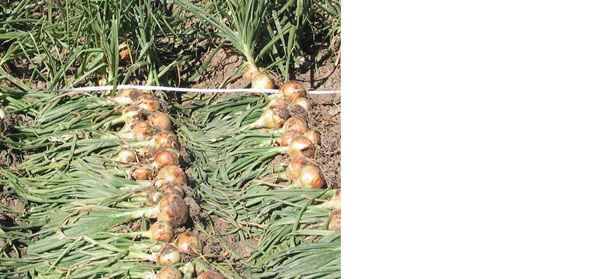

Jun 14, 2012Treasure Valley onion growers converting to drip irrigation
Onion growers typically use three types of irrigation systems: furrow, sprinkler and drip.
Conversion to drip irrigation systems has been increasing for more than two decades in the Treasure Valley area, ranging from Oregon’s Malheur County to the onion-growing area of southwest Idaho.
In 1989, the Oregon Department of Environmental Quality (DEQ) declared northeastern Malheur County a Groundwater Management Area (GWMA). DEQ designates GWMAs when the groundwater has elevated contaminant concentrations, resulting in part from non-point sources. That part of the county was designated the first GWMA in Oregon because of elevated nitrate concentrations in the groundwater.
Clint Shock, superintendent of the Oregon State University (OSU) Malheur Experiment Station, attributed part of the nitrate contamination to furrow irrigation systems common in the area at the time.
“We were leaching an awful lot of nitrogen with our furrow irrigation system,” Shock said. “So, we tried – on a very small scale – drip versus furrow versus sprinkler.”
Shock said that data accumulated over the following four years showed drip to be a better system than furrow.
“I was surprised that drip beat the furrow so handily in terms of yield,” he said.
Growers take notice
Onion growers in the Treasure Valley have taken notice of the increased yields and are converting to drip irrigation systems.
Compared to a furrow system, drip systems use approximately 40 percent less water. By applying water directly to the onion’s root zone, little is lost to surface evaporation or deep percolation, according to OSU.
Research has shown that because of better control of water application through a drip system, nitrogen applications can be reduced – thereby reducing the nitrate leaching through the soil.
Mike Thornton, superintendent of the Southwest Idaho Research and Extension Center, said 35-40 percent of onion acres in the Treasure Valley are now using drip irrigation systems.
“With furrow, you have losses due to runoff because it has to get to the end of the field, and losses through evaporation,” Thornton said. “With pivot, your main loss is through evaporation.”
Along with higher yields, another factor in favor of drip irrigation is the uniformity of the crop. With fertilization going directly to the plants and less leaching, you’re going to have more uniform distribution of nutrients to the plants, Thornton said.
According to Shock, drip irrigation was used more than 40 years ago in areas with an insufficient water supply, but that’s not why Treasure Valley growers are converting to drip systems now.
“What we try to do is grow an optimal crop, so we married irrigation scheduling with drip irrigation, Shock said.
When to water
Shock said that watering as much with drip as with furrow would rot the crop out.
“Onion yields are a contradiction in terms, because they don’t really use as much water as a lot of crops, but they need the soil to be kept wetter,” Shock said. “Onions require soil that is a lot wetter than is needed for potatoes or sugar beets.”
Shock stressed that irrigation scheduling is an important factor in every irrigation system.
Onions have little tolerance for water stress. Bulb market grade and single-centeredness are influenced by even small increments of water stress, according to an OSU Extension bulletin.
Therefore, it’s imperative to develop an informed means to determine when to irrigate your crop, according to OSU.
Irrigation scheduling in the Treasure Valley is accomplished by either soil water tension (SWT) using a graph of soil moisture, or crop evapotranspiration (ET) using the checkbook method. SWT is a measure of how much water is held in the soil. Using Granular Matrix Sensors (GMS) buried below the double rows of onions, GMS can be read using a handheld meter to log current SWT and determine the appropriate time to irrigate, according to OSU.
Crop ET represents the combination of evaporation of water from soil surface and crop water use. Growers can use weather stations to calculate crop ET values. The checkbook method consists of maintaining a log of irrigation, rainfall, estimated daily ET and accumulated net ET from one watering to the next, according to OSU.
By Bill Schaefer, VGN Contributing Editor
none














